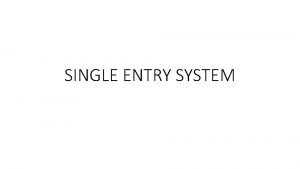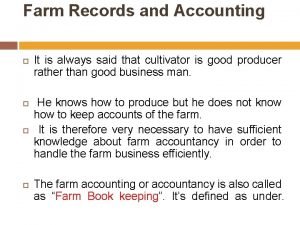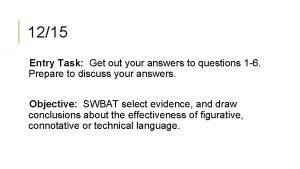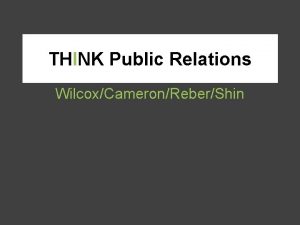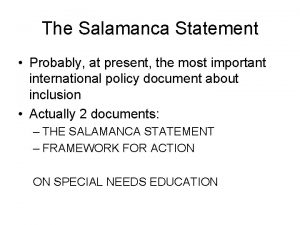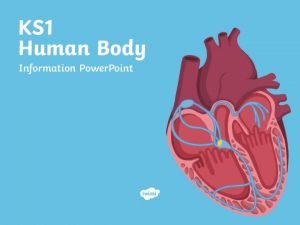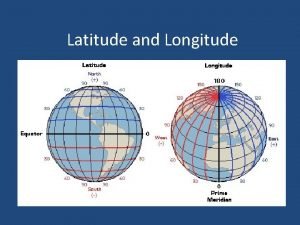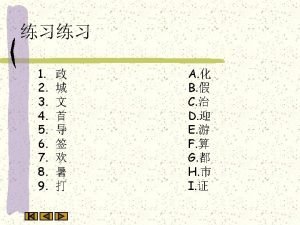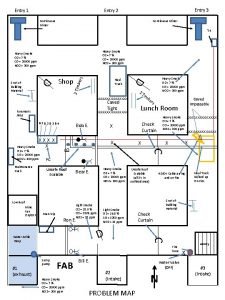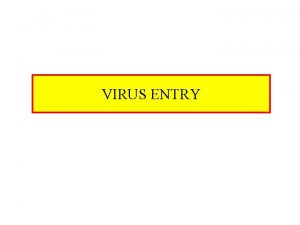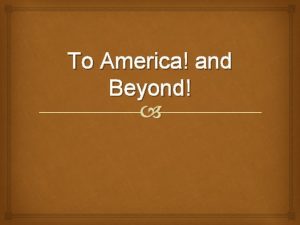Entry Task What was the most important thing






















- Slides: 22

Entry Task • What was the most important thing you learned while reading Chapter 8 – Political Geography? ▫ Why is that the most important thing?

Chapter 8 Reading Quiz Ready?

TEST Debrief • Most commonly missed questions • FRQ grading ▫ You will receive the actual APHG FRQ rubric for the questions you wrote about. ▫ Grade your classmates’ questions like normal but use the rubrics as your guide. ▫ Write the score at the top.

Political Boundaries Unit 4 – Political Geography

Objectives • Content: WWBAT explain how different shapes of states and types of borders can have poistive and negative impacts. Language: WWBAT read analyze an atlas.

US v. Mexico Border • The boundary between the United States and Mexico represents one of the greatest divisions of wealth on Earth. • Other possibilities include North Korea/South Korea or South Africa/Botswanan. • Activity 1: ▫ Examine the data on the US v. Mexico and then answer the questions at your table in a discussion.

US v. Mexico Border • What is the definition of “political boundary”? • What purpose do political boundaries serve? • Do geometric boundaries effectively separate people? • What impact does the United States/Mexico border have on the lives of people on either side of the boundary?

Activity 2 – Atlas Search • Use an atlas to find two examples of each type of political boundary listed on the worksheet. • List the two countries or states that make up each of the boundary examples. • Geometric Boundary: formed by arcs or lines (such as latitude and longitude) regardless of the physical and culture features of the earth. ▫ Often found around the states that developed out of colonial holdings, such as in Africa and the Middle East • Physical Boundary: naturally occurring divide between two areas; not man-made

Activity 3 – Short Answer Question • Choose one of the three different short answer questions listed. • Using the knowledge you gained in reading Chapter 8 and from our activity today write a complete answer to the question you choose. • WRITE YOUR ANSWER IN COMPLETE SENTENCES.

Some additional notes

Scale of Borders • Supra-national scale: organizations that transcend the boundaries of multiple countries ▫ United Nations • State scale: the political division of the Earth’s surface among different countries • Intra-state scale: further division of a state into small entities ▫ Provinces of Canada

Importance of Clear Borders • Centripetal Forces ▫ States with clearly defined borders promotes unity and cultural cohesion • Centrifugal Forces: ▫ The more boundaries and nationalities possessed by a state the higher the likelihood of conflict �Separatist movements �Regionalism �External threats

Types of Borders • Physical boundaries: ▫ Utilize natural landforms to create separations �Rivers, lakes, mountains, etc….

Types of Borders • Geometric Borders: ▫ Straight lines that create separation and are unrelated to landforms or culture

Types of Borders • Ethnic borders: ▫ Borders that attempt to reflect the cultural differences of the people living in a particular area �Often result in ethnic enclaves and exclaves • Religious/Language borders ▫ Boundaries that divide different religious groups or language families

Enclaves and Exclaves ENCLAVES EXCLAVES • Territories completely surrounded by another country but are culturally/ethnically different • Regions that are geographically separated from the rest of the country but not wholly surrounded by one state

Subsequent vs. Antecedent Boundary SUBSEQUENT BOUNDARY ANTECEDENT BOUNDARY • A boundary that is established after the settlement with an attempt to accommodate cultural differences. • A boundary that already existed before the present settlement in that area occurred. • Developed with the evolution of the cultural landscape and is adjusted as the cultural landscape changes. • The cultural landscape emerged and stayed in place while people moved in to occupy the surrounding area.

Relict Boundaries • A political boundary that has ceased to function but the imprint of which can still be detected on the cultural landscape ▫ Berlin

Superimposed Boundary • A political boundary placed by powerful outsiders on a developed human landscape

Fortified Boundaries • The creations of walls/barriers to either prevent foreigners from getting in , or its citizens from getting out

Maritime Boundaries • Division of different claims to the oceans around the shores of the country ▫ Generally accepted to be 200 nautical miles ▫ Water equally divided among countries located close to each other

Homework • Boundary Homework ▫ Review of vocabulary �A few new terms that are not in your book so you will need to look them up online ▫ Finding examples of different boundaries ▫ Identify the advantages and disadvantages of different kinds of boundaries • DUE: Thursday, Dec. 3
 эссе the most important thing in life is work
эссе the most important thing in life is work Newspaper article format
Newspaper article format From most important to least important in writing
From most important to least important in writing Least important to most important
Least important to most important Double entry system
Double entry system Define new entry in entrepreneurship
Define new entry in entrepreneurship Difference between single entry and double entry system
Difference between single entry and double entry system Entry task questions
Entry task questions Entry task questions
Entry task questions Tiered task bias task
Tiered task bias task The most precious thing in my room
The most precious thing in my room What is the most basic thing on the ph scale
What is the most basic thing on the ph scale Most basic thing in the world
Most basic thing in the world Most creative thing
Most creative thing The most difficult persuasive task is to
The most difficult persuasive task is to Doctrine and covenants 130
Doctrine and covenants 130 Salamanca declaration
Salamanca declaration Resocialization synonym
Resocialization synonym Resocialization
Resocialization Most important part of the body
Most important part of the body Imaginary horizontal
Imaginary horizontal International students inc
International students inc What are the two basic requirements for a healthy scalp?
What are the two basic requirements for a healthy scalp?




